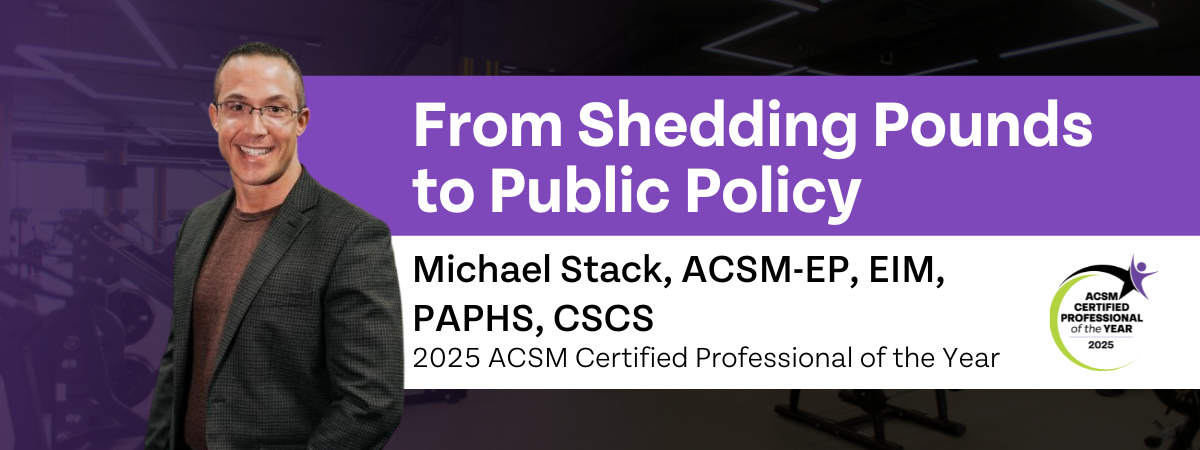
From Shedding Pounds to Public Policy
Get to Know 2025 ACSM Certified Professional of the Year Michael Stack
ACSM Certified Professionals of the Year tend to spend most of their time in overdrive, and Michael Stack is no different. When the 2025 winner and I sat down to chat, I tossed a couple questions his way about his hobbies and interests, and he admitted that his work is pretty much his life. But in a fulfilling rather than draining way. And Stack shares that since at least age 18, he’s lived by a consistent principle: Figure out how to be of service.
Stack is president of the Physical Activity Alliance, or “PAA,” a coalition of the nation’s leading health nonprofits and the largest of its kind in the US. Naturally, the alliance is dedicated to promoting physical activity. Stack is also the founder of the Michigan Moves Coalition (a Michigan-focused organization similar to the PAA), founder and CEO of Applied Fitness Solutions (“AFS”; a boutique fitness and wellness provider) and the host and creator of the Wellness Paradox Podcast (well worth a listen). He is an ACSM Certified Exercise Physiologist®, holds an Exercise is Medicine® credential and ACSM Physical Activity and Public Health Specialist certificate, and earned a CSCS certification from the NSCA.
Warm-Up Reps
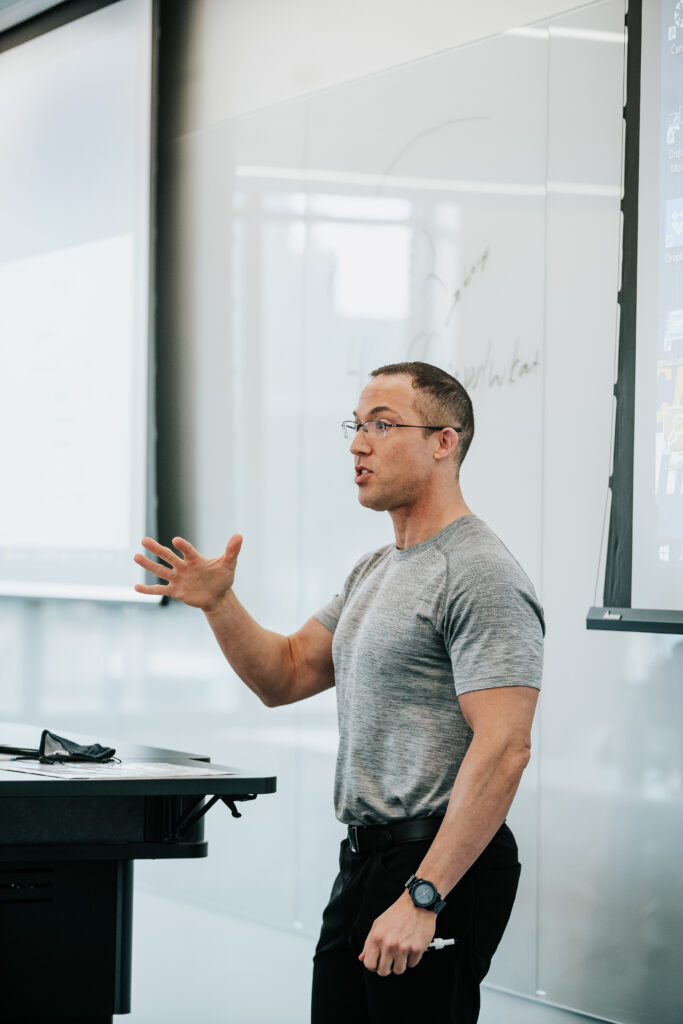
Stack’s start in the fitness world began at the local YMCA at age 13. He was extremely overweight, at one point tipping the scales at about 280 lbs., and was unhappily nicknamed “Fat Stack” by his classmates.
“You would think would leave a really deep scar somewhere inside of me,” Stack says. “But it actually turned into be one of the things I’m most grateful for is an experience, because it led me to this little YMCA gym in Westland, Michigan.”
Crucially, one of the other gymgoers took Stack under his wing, and with gentle encouragement, the teenager began to improve. Stack never looked back.
“He mentored me, and he made me feel safe, he made me feel welcomed. He made me feel like I belonged, and so that that little gym was the first place that I felt like I could be me socially.”
But it wasn’t just a social experience, of course. Stack began training regularly and even had other patrons come to him for advice. Within two years, he was writing fitness programs for other gymgoers.
“I would argue I started at 15 years old as a trainer in that YMCA because people were paying me,” he says, adding: “Let’s not look at the programs that a 15-year-old might have written for people.”
At 18, Stack took on a job as a trainer at Bally Total Fitness, and for the next nine years, he would work as a trainer in various commercial gyms. During this time, he also enrolled at Madonna University in Livonia, Michigan, earning an associate’s in business administration in 2001; then it was on to the University of Michigan in Ann Arbor for a bachelor’s in kinesiology, where he also served as a teaching assistant. He’s since held lecturer positions at both Eastern Michigan University’s School of Health Promotion & Human Performance and the University of Michigan’s School of Kinesiology.
The COVID-19 Pivot
It probably comes as no surprise that a large fitness business was severely impacted by the COVID-19 era lockdowns. Michigan’s policies were strict, and Stack reports that AFS had its doors closed for roughly six months. He felt he and other business owners like him had no representation at the state capital.
“This isn’t a political statement,” he says. “This is just a statement of fact. … It caused me to get involved in advocacy, to start to work with lawmakers, and it really led me on this path to being the president of the PAA right now.”
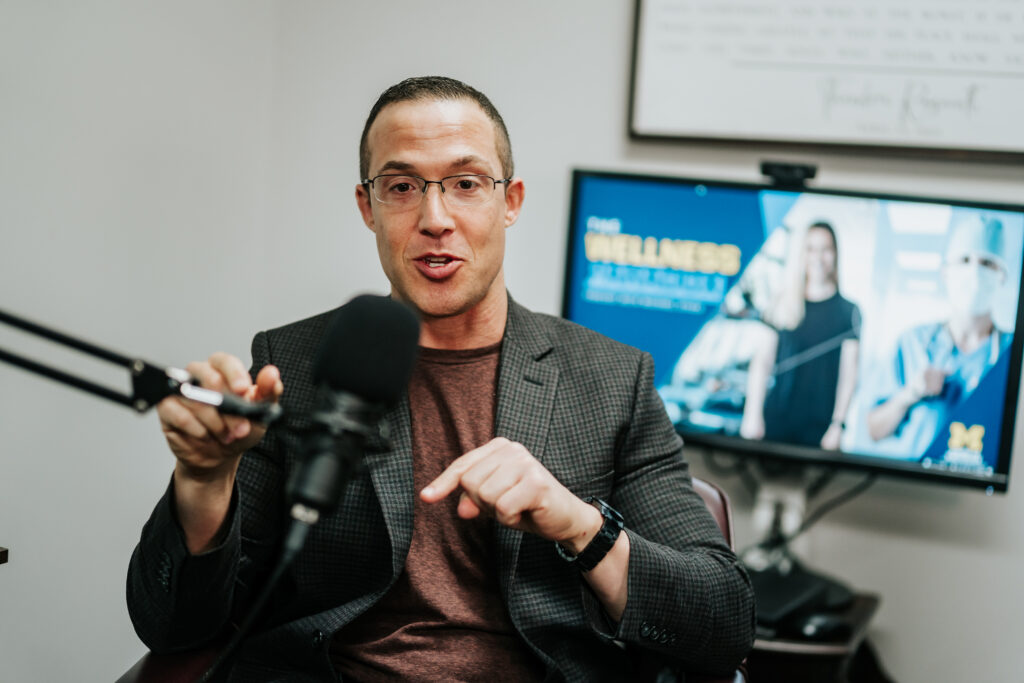 It was also the period he founded the Michigan Moves Coalition, an Ann Arbor-based advocacy group comprising the state’s major physical activity-promoting organizations, which champions the health benefits of active lifestyles for all Michiganders.
It was also the period he founded the Michigan Moves Coalition, an Ann Arbor-based advocacy group comprising the state’s major physical activity-promoting organizations, which champions the health benefits of active lifestyles for all Michiganders.
Nor was it likely a coincidence that he started the Wellness Paradox Podcast in April 2021 in partnership with the University of Michigan School of Kinesiology. His episodes run the gamut from mitigating exercise professionals’ potential legal liabilities to the role of weight management drugs, but the major theme is the professionalization of the exercise landscape. The podcast also includes a series dedicated to professionalization and content from ACSM’s Health and Fitness Journal®, aka “FIT.”
As for his own business, Stack took the otherwise dire COVID-19 policy situation as an opportunity to realign his goals and services. It was the first time since 2007, he says, that AFS was able to “land the plane and reassess things.” In late 2020 to early 2021, he began to move the organization into the medical health and wellness rather than purely fitness space.
The shift mirrors the path forward that individual organizations like ACSM and collective policy groups like the PAA are taking.
The PAA
Physical Activity Assessment
Stack has a number of goals as PAA president. The first we discussed was the effort to make physical activity assessment a standard of care in the medical field. This sort of thing seems dead obvious to those of us in the exercise world. But policy and cultural change are difficult, and inertia does its best to keep on keepin’ on. Stack is keenly aware that most health care providers are strapped for time, and it’s his belief that making a physical activity assessment a standard and easily accessed element of electronic health record (EHR) systems will get the ball rolling in a new and better direction. The next step would then be to allow physicians and other providers to easily refer patients out for physical activity training.
The PAA has already invested the time and funds into an implementation guide that walks health care systems step by step through the process of adding a physical activity assessment safely and securely into their EHR.
“The technological mechanism exists for this right now,” Stack says. “We just need uptake from health systems. Starting in 2027, I believe, physical activity will be a required vital sign inside of electronic health records as mandated by the federal government. But just because it’s a required measure doesn’t mean it’s a utilized measure. That’s where the uptake piece becomes so important.”
Creating Qualified Health Care Professionals
Another piece of the puzzle? Getting exercise professionals recognized as qualified health care professionals, or “QHPs.” The goal is simple enough: Make those who provide physical activity and related services eligible to directly bill medical payers (e.g., health insurance providers, Medicare) for their services. Doing so requires convincing said payers that it is medically and financially wise to treat exercise professionals like other medical providers. That is, does exercise improve clinical outcomes? And do exercise interventions prevent people for undergoing costlier interventions?
“The first step in this QHP movement is approaching the payer community and the provider community as a coalition. That is absolutely critical,” Stack says. “And they’ve told us that for many, many years. That’s why the Physical Activity Alliance exists, because they don’t want to hear separately from ACSM, the YMCA and ACLM. They want to hear from one unified voice.”
A major policy inflection point, then, is the Centers for Medicare and Medicaid Services (CMS), which is the payer for more than half of the country.
“As CMS goes, so do they private payers go eventually,” Stack says.
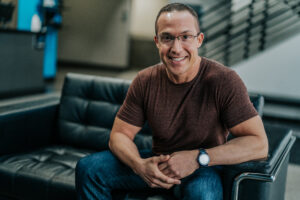 To convince CMS that exercise and physical activity are effective and ultimately cost saving, the PAA had to have real data. The best field for that seemed to be exercise oncology. Thus, ACSM Past President Kathryn Schmitz, PhD, MPH, FACSM, who started the EIM task force Moving Through Cancer, submitted what’s known as a “national coverage determination” for exercise and cancer, which is working its way through the CMS approval process.
To convince CMS that exercise and physical activity are effective and ultimately cost saving, the PAA had to have real data. The best field for that seemed to be exercise oncology. Thus, ACSM Past President Kathryn Schmitz, PhD, MPH, FACSM, who started the EIM task force Moving Through Cancer, submitted what’s known as a “national coverage determination” for exercise and cancer, which is working its way through the CMS approval process.
“The reason that that is going first is because that there is the best cost effectiveness data: exercise and cancer,” Stack says. “This is no longer a conversation about efficacy. We don’t need to show people that exercise works anymore. Everyone universally agrees that exercise works. What we have to show the payers is that if they spend $1 on exercise that they’re going to save more than $1. It’s more about cost effectiveness than it is efficacy at this point. And Dr Schmitz’s work has really borne out the cost effectiveness.”
After the exercise vs. cancer push, the next step will likely be exercise vs. fall prevention. And so the journey toward QHP will continue.
“So that’s the way we go about it,” Stack says. “We get a couple of chronic conditions that there’s good cost effectiveness data on. We show that cost effectiveness to the government as a payer who’s looking at things more from a value-based lens than a volume lens. And then from there we start we aggregate a couple of coverage determinations together — four, five, six — and then eventually, hopefully, we can just get a broad coverage determination for supervised exercise therapy.”
Stack on Stack
We close with a bit of a recap. Stack is driven, he says, by a set of values he developed at age 18 and that, though they’ve naturally evolved over the years, have remained remarkably consistent: impact, growth and service.
“Everything that I do in my life is connected to those core values, and that’s what makes all of my decisions in life so easy to make,” he says. “Does this align with my value or does it not? If it does, I’m doing it and I’m diving in. If it doesn’t, I’m not doing it.”
As for being named 2025 ACSM Certified Professional of the Year, Stack is eager to use the platform to show others what’s possible.
“The reason that I’m excited that I got this award is not because I’m interested in getting awards,” Stack says. “It’s because I want this to be an example of a unique alternative path for people to take in their career as an exercise professional. Yes, we needed individual exercise professionals. Yes, we need business owners. But we also need — maybe, now more than ever — people are willing to advocate for policy and systems change. I didn’t think that I had it in me to be an advocate. I had no idea what it even meant. And it’s a path that I found very rewarding.”
Story by Joe Sherlock
Images courtesy of Michael Stack
Published March 2025
